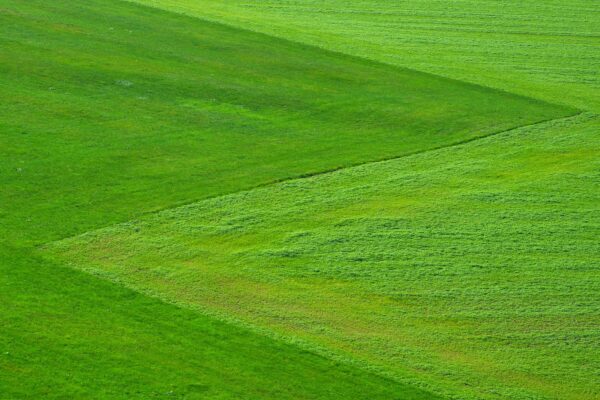Evolution of Artificial Grass Materials
Artificial grass has made remarkable strides since its initial days. The history of artificial grass is a testimony to human creativity and ingenuity, as it has continually evolved to meet the changing needs of society. In its journey of more than half a century, the material composition of artificial grass has undergone significant transformation, leading to the sophisticated product we see today.
In its earliest form, artificial grass was simply a short pile product made entirely of chlorinated fibres. This first generation of artificial grass was essentially a carpet, designed with a sole purpose – to mimic the appearance of natural grass. Its main selling point was its ability to thrive under conditions where natural grass could not survive, such as indoor stadiums with limited sunlight.

The primary material used in the construction of first-generation artificial grass was nylon. The fully chlorinated fibres of this synthetic turf were closely tufted and filled with a foam backing for support. The result was a hard and abrasive surface that, while relatively durable, lacked the aesthetic appeal and comfort of natural grass. It also retained heat, leading to a higher surface temperature than that of natural grass.
The second generation of artificial grass introduced an important component – sand infill. The role of the sand was multidimensional. Firstly, it added stability to the synthetic grass blades, helping them stand upright. Secondly, it provided a degree of cushioning, making the turf softer and safer to play on. Lastly, the sand infill contributed to a more realistic look, giving the artificial grass a more authentic, natural grass-like appearance.
Although the second generation of artificial grass was a marked improvement over the first, it still had room for advancement. The sand infill, while offering multiple benefits, also had its drawbacks. It was abrasive and could cause injuries to athletes. The sand would also compact over time, reducing its cushioning properties and requiring periodic replenishment. Furthermore, the sand-infill turf still lacked the overall performance characteristics of natural grass.
Enter the third generation of artificial grass, an innovation that significantly upped the ante in terms of aesthetics, performance, and durability. This generation marked a shift from nylon to polyethylene and polypropylene yarns, materials that are softer and less abrasive than their predecessor. The third-generation turf boasted of longer, more natural-looking blades that could better replicate the look and feel of real grass.
The infill material also underwent a transformation. Instead of solely sand, a mixture of sand and rubber granules became the new standard for infill. The rubber granules provided superior cushioning, improved the turf’s performance characteristics, and reduced the risk of injuries. The third generation of artificial grass aimed to provide not just a grass-like appearance but also to offer comparable playability and safety.
Today, the third generation of artificial grass is the most commonly used variant, appreciated for its optimal blend of aesthetics, performance, and durability. However, the evolution of artificial grass materials is a continuous process. Technology is always striving for better products, and artificial grass is no exception.
The advent of thermoplastic elastomer (TPE) and ethylene propylene diene monomer (EPDM) infills, the development of shock-absorbing pads for enhanced safety, the experimentation with plant-based materials for eco-friendliness are all part of the ongoing evolution in the world of artificial grass.
As we look towards the future, the focus is shifting towards creating sustainable, recyclable artificial grass that can deliver high performance while minimising the environmental footprint. The goal is to develop artificial grass that combines the best of all worlds – the aesthetics of natural grass, the durability of synthetic fibres, the safety of advanced infills, and the sustainability of eco-friendly materials.
The path of progress has seen artificial grass cross several milestones, with each new generation of turf being superior to its predecessor. From introducing sand infill for stability and aesthetics, to replacing nylon with softer polyethylene and polypropylene yarns, to enhancing safety with rubber granules, each evolutionary step has made artificial grass closer to natural grass in looks and performance.
As we march towards an environmentally conscious future, the evolution of artificial grass materials is aligning with the principles of sustainability and recyclability. We’re witnessing the emergence of bio-based, renewable materials being used in the construction of artificial grass. Infill materials are also evolving to be more eco-friendly, with organic and plant-derived products making their way into the artificial grass industry.
Research and development in the field are ongoing, with scientists and manufacturers continually exploring ways to improve the product. Efforts are underway to improve UV resistance, reduce surface temperature, enhance drainage capacity, and make the turf more resilient. On the sustainability front, the focus is on developing fully recyclable artificial grass that can be responsibly disposed of at the end of its lifecycle.
The artificial grass of today is a far cry from its original version. The materials used, the construction process, the design and aesthetics, all bear the marks of relentless innovation and advancement. And yet, the journey is far from over. As we move forward, we can expect to see further improvements in the design, materials, and manufacturing processes of artificial grass, making it even more versatile, durable, and sustainable.
In the grand story of artificial grass, the evolution of its materials plays a pivotal role. It’s a narrative of progression, adaptation, and a relentless pursuit of excellence. As we look towards the future, the evolutionary journey of artificial grass continues to inspire, promising further advancements and innovations that will continue to reshape our perception of outdoor aesthetics.
